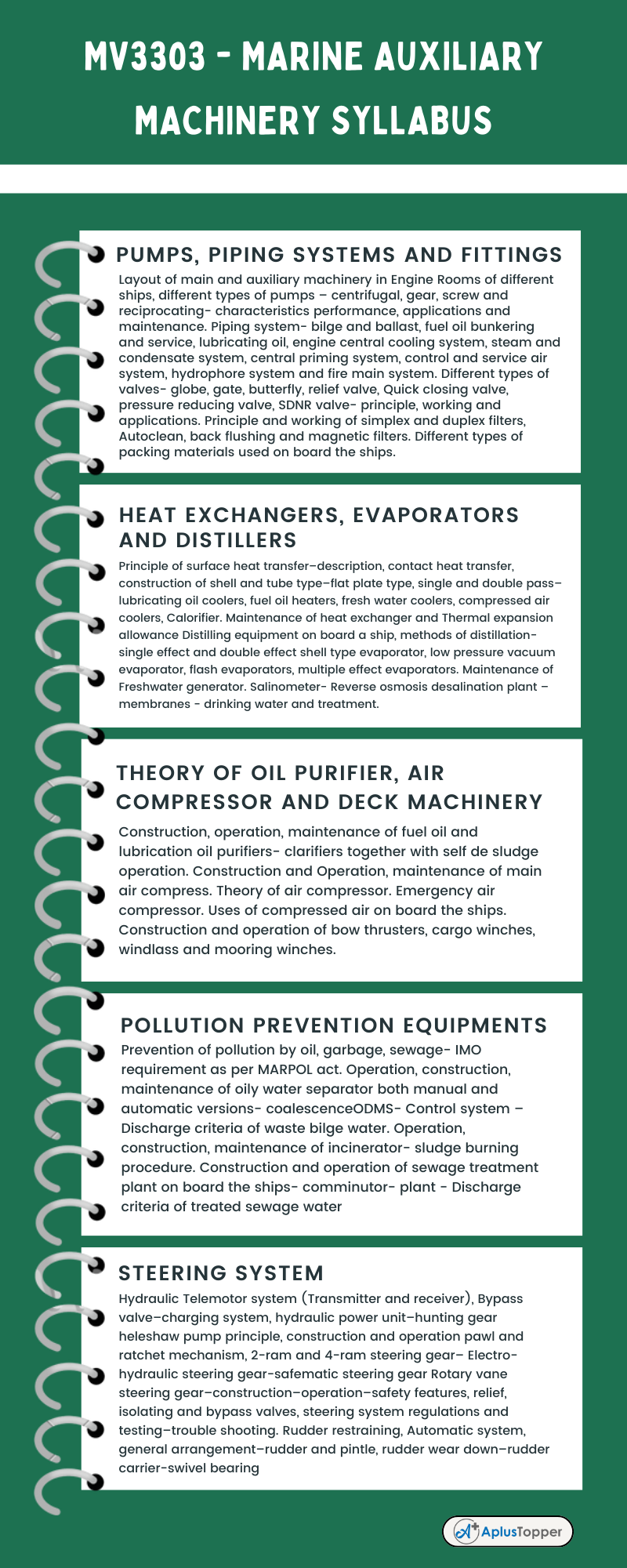Marine Auxiliary Machinery is a dynamic subject that continuously shifts from one perspective to another. However, the technicality is the same even if the theories and perspectives vary. Hence to gain knowledge in this subject you must be equipped with more vicious on the syllabus.
In this article, we tried to provide the required syllabus of the MV3303 Marine Auxiliary Machinery subject to gain command of the subject matter. By the end of the course, you will be trained and guided with useful knowledge regarding technical english, which plays a major role in understanding the core of this B.E Marine Engineering semester III related to Affiliated institutions awarded by Anna University course. Hope this information is useful. Kindly share it with your friends. Comment below if you have queries regarding the syllabus.
If you want to know more about the syllabus of B.E. Marine Engineering connected to an affiliated institution’s four-year undergraduate degree program. We provide you with a detailed Year-wise, semester-wise, and Subject-wise syllabus in the following link B.E. Marine Engineering Syllabus Regulation 2021 Anna University.
Aim Of Concept:
- To impart knowledge on pumps, piping systems and its fittings
- Inculcate knowledge on heat exchanger, evaporators and distillers
- To acquire peripheral knowledge on oil purifier, air compressor and deck machinery.
- To impart knowledge on pollution prevention equipment’s
- To understand the concepts of steering gear system
MV3303 – Marine Auxiliary Machinery Syllabus
Unit I: Pumps, Piping Systems And Fittings
Layout of main and auxiliary machinery in Engine Rooms of different ships, different types of pumps – centrifugal, gear, screw and reciprocating- characteristics performance, applications and maintenance. Piping system- bilge and ballast, fuel oil bunkering and service, lubricating oil, engine central cooling system, steam and condensate system, central priming system, control and service air system, hydrophore system and fire main system. Different types of valves- globe, gate, butterfly, relief valve, Quick closing valve, pressure reducing valve, SDNR valve- principle, working and applications. Principle and working of simplex and duplex filters, Autoclean, back flushing and magnetic filters. Different types of packing materials used on board the ships.
Unit II: Heat Exchangers, Evaporators And Distillers
Principle of surface heat transfer–description, contact heat transfer, construction of shell and tube type–flat plate type, single and double pass–lubricating oil coolers, fuel oil heaters, fresh water coolers, compressed air coolers, Calorifier. Maintenance of heat exchanger and Thermal expansion allowance Distilling equipment on board a ship, methods of distillation- single effect and double effect shell type evaporator, low pressure vacuum evaporator, flash evaporators, multiple effect evaporators. Maintenance of Freshwater generator. Salinometer- Reverse osmosis desalination plant – membranes – drinking water and treatment.
Unit III: Theory Of Oil Purifier, Air Compressor And Deck Machinery
Construction, operation, maintenance of fuel oil and lubrication oil purifiers- clarifiers together with self de sludge operation. Construction and Operation, maintenance of main air compress. Theory of air compressor. Emergency air compressor. Uses of compressed air on board the ships. Construction and operation of bow thrusters, cargo winches, windlass and mooring winches.
Unit IV: Pollution Prevention Equipments
Prevention of pollution by oil, garbage, sewage- IMO requirement as per MARPOL act. Operation, construction, maintenance of oily water separator both manual and automatic versions- coalescenceODMS- Control system – Discharge criteria of waste bilge water. Operation, construction, maintenance of incinerator- sludge burning procedure. Construction and operation of sewage treatment plant on board the ships- comminutor- plant – Discharge criteria of treated sewage water

Unit V: Steering System
Hydraulic Telemotor system (Transmitter and receiver), Bypass valve–charging system, hydraulic power unit–hunting gear heleshaw pump principle, construction and operation pawl and ratchet mechanism, 2-ram and 4-ram steering gear– Electro-hydraulic steering gear-safematic steering gear Rotary vane steering gear–construction–operation–safety features, relief, isolating and bypass valves, steering system regulations and testing–trouble shooting. Rudder restraining, Automatic system, general arrangement–rudder and pintle, rudder wear down–rudder carrier-swivel bearing
Text Books:
- H.D. McGeorge, “Marine Auxiliary machinery”, 7th edition, Butterworth’s, London, 2011.
- Leslie Jackson and Thomas D. Morton, “Reed’s general engineering Knowledge for marine engineers”, 4th edition, Thomas Reed’s, 1 999.
- DW Smith, “Marine auxiliary machinery”, 6th edition, Butterworth’s, London, 1987.
Reference Books:
- Heinz P Bloch, Fred K Geitner,” Machinery Component Maintenance and repair” 3rd edition, Elsevier,2010.
- MARPOL 73/78, IMO Publication, 2001.
- Vikram Gokhale, N. Nanda, “Advanced Marine Engineering Knowledge Vol. II”, 2nd Edition, Engineer Enterprises, Mumbai, 2001.
- “Pumping and Piping Diagram”, IME Publication 1999.
- Vikram Gokhale & N. Nanda, “Marine Engineering Knowledge for Junior Engineers, 3rd Edition, Engineer Enterprises, Mumbai, 1999.
- DK Sanyal, “Principle and Practices of marine diesel engine” 2nd edition, Bhandarkar Publication, Mumbai, 1998.
Related Posts On Semester – III:
- MA3351 – Transforms and Partial Differential Equations
- MV3301 – Marine Hydraulics and Fluid Machinery
- MV3302 – Strength of Materials for Marine Engineering
- MV3304 – Ship Construction
- MV3305 – Seamanship, Elementary Navigation and Survival at Sea
Must Read For More:
